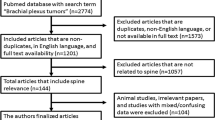Abstract
Background
In breast cancer (BC) patients the brachial plexus syndrome (BPS) has been reported to be due to loco-regional metastases or radiation plexopathy. Associated arm edema is considered more suggestive of the latter. Radiation therapy is the only effective treatment for BPS reported.
Methods
The charts of all BC patients who presented to our clinic from 1982 to 2006 with homolateral arm pain and neurological deficits, without humerus, cervical spine, or brain metastases, were reviewed.
Results
There were 28 patients fulfilling these criteria for BPS. Supraclavicular, axillary or chest wall metastases developed synchronously with the BPS in 26 patients; in 21 they were recurrences, found 6–94 months (median 34 months) after primary BC treatment, while in 5 others they were progressing inoperable primary tumors and nodes. Arm edema first occurred at the same time as loco-regional metastases in 19 patients. Treatment for the BPS was administered to 22 patients; it was directed at their locoregional metastases. The BPS was initially treated with radiation (8 patients) or chemo- or endocrine therapy (14 patients); 19 (86%) had partial or complete remission of pain and neurologic deficits, with an 8-month median duration.
Conclusion
The BPS in BC patients is due to loco-regional metastases and is often associated with arm edema. Chemoor endocrine therapy induced the remission of pain and deficits as frequently as radiation therapy.
Similar content being viewed by others
References
Cherny NI, Kaufman B (2000) Brachial plexopathy. In: Harris JR, Lippman ME, Morrow M, Osborne CK (eds) Diseases of the breast. Lippincott, Williams and Wilkins, Philadelphia, chapter 55, 875–888
Harper CM Jr, Thomas JE, Cascino TL, et al. (1989) Distinction between neoplastic and radiation-induced brachial plexopathy, with emphasis on the role of EMG. Neurology 39:502–506
Kori SH, Foley KM, Posner JB (1981) Brachial plexus lesions in patients with cancer: 100 cases. Neurology 31:45–50
Lederman RJ, Wilbourn AJ (1984) Brachial plexopathy: recurrent cancer or radiation? Neurology 34:1331–1335
Ebner I, Anderl H, Mikuz G, et al. (1990) Plexus neuropathy: tumor infiltration or radiation damage. Rofo 152:662–666
Fathers E, Thrush D, Huson SM, et al. (2002) Radiation-induced brachial plexopathy in women treated for carcinoma of the breast. Clin Rehabil. 16:160–165
Johansson S, Svensson H, Denekamp J (2000) Timescale of evolution of late radiation injury after postoperative radiotherapy of breast cancer patients. Int J Radiat Oncol Biol Phys 48: 745–750
Bajrovic A, Rades D, Fehlauer F, et al. (2004) Is there a life-long risk of brachial plexopathy after radiotherapy of supraclavicular lymph nodes in breast cancer patients? Radiother Oncol 71: 297–301
Pierce SM, Recht A, Lingos TI, et al. (1992) Joint Center for Radiation Therapy, Boston, MA 02115. Long-term radiation complications following conservative surgery (CS) and radiation therapy (RT) in patients with early stage breast cancer. Int J Radiat Oncol Biol Phys. 1992;23:915–923. Comment in: Int J Radiat Oncol Biol Phys 23:1085–1086
Greene FL, Page DL, Fleming ID, et al. (eds) (2002) American Joint Committee on Cancer staging manual, 6th edn. Springer-Verlag, New York Heidelberg Berlin Tokyo, pp 223–240
Cooke J, Powell S, Parsons C (1988) The diagnosis by computed tomography of brachial plexus lesions following radiotherapy for carcinoma of the breast. Clin Radiol 39:602–606
Thyagarajan D, Cascino T, Harms G (1995) Magnetic resonance imaging in brachial plexopathy of cancer. Neurology 45:421–427
Kichari JR, Hussain SM, Den Hollander JC, et al. (2003) MR imaging of the brachial plexus: current imaging sequences, normal findings, and findings in a spectrum of focal lesions with MR-pathologic correlation. Curr Probl Diagn Radiol 32:88–101
Wittenberg KH, Adkins MC (2000) MR imaging of nontraumatic brachial plexopathies: frequency and spectrum of findings. Radiographics 20:1023–1032
Qayyum A, MacVicar AD, Padhani AR, et al. (2000) Symptomatic brachial plexopathy following treatment for breast cancer: utility of MR imaging with surface-coil techniques. Radiology 214: 837–842
Lingawi SS, Bilbey JH, Munk PL, et al. (1999) MR imaging of brachial plexopathy in breast cancer patients without palpable recurrence. Skeletal Radiol 28:318–323
Hall EJ (1994) Radiobiology for the radiologist. JB Lippincott, Philadelphia, chapter 13, 224–227
Tovey SM, Witton CJ, Bartlett JMS, et al. (2004) Outcome and human epithelial growth factor receptor (HER) 1–4 status in invasive breast carcinomas with proliferation indices evaluated using bromodeoxyuridine (BrdU) labeling. Breast Cancer Res 6: R246–251
Ganel A, Engel J, Sela M, Brooks M (1979) Nerve entrapments associated with postmastectomy lymphedema. Cancer. 44:2254–2259
Ampil FL (1985) Radiotherapy for carcinomatous brachial plexopathy. Cancer 56:2185–2188
Author information
Authors and Affiliations
Corresponding author
Additional information
Part of these data were previously published in abstract form: Braverman AS, Kamenova BS, Efiom-Ekaha D, Sohn C (2005) Brachial plexus syndrome (BPS) due to primary or locally recurrent breast cancer (BC). Proc ASCO (# 748) 655
About this article
Cite this article
Kamenova, B., Braverman, A.S., Schwartz, M. et al. Effective treatment of the brachial plexus syndrome in breast cancer patients by early detection and control of loco-regional metastases with radiation or systemic therapy. Int J Clin Oncol 14, 219–224 (2009). https://doi.org/10.1007/s10147-008-0838-3
Received:
Accepted:
Published:
Issue Date:
DOI: https://doi.org/10.1007/s10147-008-0838-3




